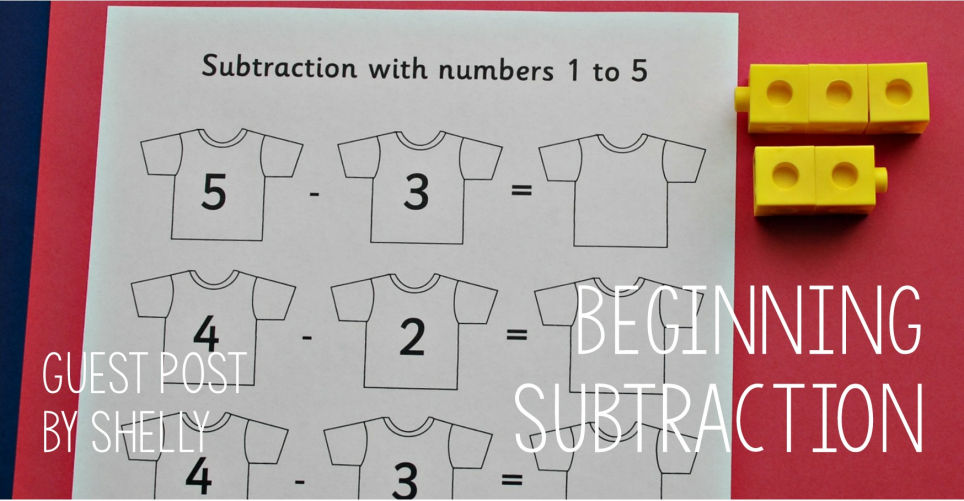Subtraction can sometimes be a little bit scarier than addition for kids to learn, so Shelly has written about some fun ideas to help in this useful guest post.

Beginning Subtraction
By Shelly
There is something about subtraction that seems to make it a bit scarier that addition. So I thought I would share some ideas on how we worked on subtraction in our house.
1. Physically taking objects away
Subtraction means something is taken away, a number is made smaller. So when you are starting subtraction sums there is nothing better than giving the kids objects to work with. Place 4 counters in front of the kids and ask them what happens if they take 2 away. Lots of kids understand maths better if they can physically handle objects and move objects around. We used counters a lot with basic subtraction sums.

Football shirt subtraction using counters to physically take away
2. Counting backwards
Yes this really helps. If your kids are battling with the idea of subtraction, spend some time making sure that they comfortable with countdowns / counting backwards. And not just counting back in ones: try and make a game of it and see who can count backwards in two’s, fives or tens. And mix it up and give them strange random starting points – so you don’t always count backwards in twos from an even number, see if they can do it from an odd number too. It takes practice. We often do this in the car driving to activities. But the more they practice this and the quicker they get the easier subtracting 2’s, 5’s and 10’s will become. And if they start finding simpler subtraction sums easier they will be confident when trying harder subtraction sums.
Plus counting back enforces one of the common subtraction methods – using a number line (and don’t just think of number lines to 10 we have some up to 50 and even 100).

Subtraction worksheet with number lines
Number line are great. At different stages we have had different number lines stuck up around the house.

Lily pad number line in action with a toy frog
And with a number line the kids can use other objects – so when they need to jump back 4 (i.e. subtract 4 spaces), why not give them a small toy or object to use.
3. Understanding that subtraction is the inverse of addition
Number bonds come in really handy with this. When we did a number bond we would always look at the addition sums and then convert the addition sums into subtraction sums. When my daughter was younger she really struggled with subtraction and this was the key for her - just sitting down and writing out addition sums and then converting the addition sums into subtraction sums. Even now when she gets stuck with a harder subtraction sum e.g. 21-17 she will often solve it by thinking of the inverse addition – she converts that subtraction sum into 17 + x = 21. She knows that 17 plus 4 gives her 21 so she knows that 21 minus 17 will be 4.
With younger kids I suggest starting with number bond addition pages like this - breaking the total down into its parts and then making sure they get that the parts added together to make a total.

Working on a subtractionn with number bonds worksheet
Once they are happy with the addition side, show them how they can convert the addition sum into subtraction.

Subtraction as the inverse of addition
If we take one part away from the total we will always be left with the other part. If they initially struggle with this don’t give up. Practise with them. Get some counters out and show them how you break the total number into two parts. Then show them what happens if you remove the one part number. Let them play around with counters and practise converting the addition sum into a subtraction sum. Spending time on this now will help later on.

Subtraction with number bonds and counters
And if you just want some subtraction practice pages - some of the Maths Facts Colouring Pages are subtraction pages.

A dragon maths facts colouring page
You can find all Activity Village's worksheets and lots more tips and tricks for mastering early subtraction skills here:

This is a guest post from Shelly. Shelly is a home educating parent of two children aged 6 and 9. She blogs at ofamily learning together where she shares ideas on their different learning activities including lots of hands-on maths, arts and crafts and anything else that is part of their home educating lifestyle.
You can find more guest posts by Shelly, and a list of all our guest posts, here.

